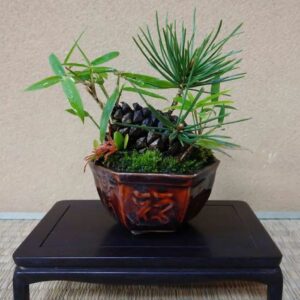Kusamono bonsai involves planting wild grass rather than a tree and is used in traditional bonsai displays as a complementary element. Today, Kusamono bonsai is a unique part of the bonsai tradition with distinct conventions and aesthetics.
Understanding Kusamono Bonsai
What is Kusamono?

Bonsai plant type
Definition
Kusamono bonsai is a type of bonsai that involves planting grass found in fields and mountains. Kusamono is a Japanese word that literally means “something made of/from grass”, where Kusa means grass and Mono means (some)thing.
Kusamono bonsai can be further divided into 3 subcategories: bamboo, wild grass, and moss. Though Kusamono bonsai traditionally uses grasses/plants in the wild, it now uses a wide variety of plants commonly found in gardening stores.
Differences between tree bonsai and Kusamono bonsai
The main difference between tree bonsai and Kusamono bonsai lies in how Kusamono bonsai try to represent nature. Although both try to imitate the natural landscape in a pot, Kusamono is less artificial and more “natural”; accepting and enjoying nameless wild plants (nature) as it is.

Kusamono in winter
For this reason, seasonality or imagery of seasons is more important for Kusamono bonsai than tree bonsai. While deciduous and flowering bonsai/fruit shows some seasonality, coniferous bonsai is evergreen and does not exhibit changes throughout the year. Kusamono being grass represents a lifecycle of birth and death within a year and rebirth the next year.

Kusamono (group planting)
Another difference is that Kusamono bonsai often feature multiple plant species in a pot, which is not usually recommended for the traditional tree bonsai. The reason for this may be more practical rather than artistic; growing different species of grasses are much easier than growing different tree species in a tiny pot.
Who is Kusamono for?
Kusamono bonsai changes its appearance drastically with the seasons and can be enjoyed throughout the year. Kusamono is easier to create than traditional tree bonsai which needs a very long time to grow and shape, making it perfect for beginners.
History of Kusamono bonsai
A brief history of Kusamono
(Source: Nippon Bonsai Association)
In a traditional bonsai display inside the house, a smaller pot planted with grass is placed alongside a bonsai tree as a complementary element to accentuate the scale of the bonsai tree and exhibit the season.
This complementary or accompanying plant is called Shitakusa, meaning under grass, because it is placed under the shelf where the main bonsai tree is displayed. As such, Shitakusa has typically been used as an accent bonsai displays rather than being the main focus of the display.
Over time, Shitakusa became more closely associated with the bonsai display, with the two displayed together to complement each other, not Shitakusa just being an accent to the bonsai tree. This led to the development of Shitakusa becoming a distinct type of bonsai as Kusamono that emphasizes the use of grass to represent nature as it is.
Today, Kusamono bonsai is recognized as a unique and important part of the bonsai tradition, with its own set of conventions and aesthetics.
As a side note, other types of bonsai are called Ha-mono (Ha=leaf), Hana-mono (Hana=flower) and Mi-mono (Mi=fruit) just like Kusa-mono (Kusa=grass).
Kusamono and Shitakusa
While the words Kusamono and Shitakusa can be used interchangeably, there is a bit of difference in how they are used. Because of the historical background, Shitakusa is more of a companion plant used to display tree bonsai while Kusamono is a type of bonsai that uses grass.
Common plants used in Kusamono bonsai
One of the most exciting aspects of Kusamono Bonsai is the wide range of plants that can be used to create beautiful and unique displays. From delicate wildflowers to ferns and mosses, there is no shortage of options for the Kusamono bonsai enthusiast.
The following are some of the most popular plants used in Kusamono bonsai.
Grasses/ferns/succulents

Kusamono (Japanese forest grass)
Grasses and ferns are a common element of Kusamono bonsai and some succulents are also planted traditionally as well. Popular options include:
- hosta (grass),
- silver mound (grass),
- Japanese secred lily (grass),
- Japanese knotweed (grass),
- selaginella tamariscina (fern), and
- mistletoe cacti (succulents).
Wildflowers

Kusamono (iris)
Wildflowers are a staple of Kusamono bonsai and can add a vibrant splash of color. Popular options include:
- orchids (e.g. cymbidium goeringii),
- chrysanthemums/primroses (e.g. asteroideae),
- violets (e.g. viola mandshurica),
- irises (e.g. iris sanguinea), and
- dandelions.
Mosses

Kusamono (moss)
(Source: Nippon Bonsai Association)
Mosses are a popular choice for Kusamono bonsai as well, which create a rustic and serene appearance. Popular options include:
- silver moss (bryum argenteum),
- starburst moss (atrichum angustatum), and
- juniper haircap moss (polytrichum juniperinum).
Bamboos

Kusamono (Broadleaf bamboo and pine)
(Source: Nippon Bonsai Association)
Popular options include:
- bamboo and
- broadleaf bamboo.
If you are interested in bamboo bonsai, please check the following post.
How to create Kusamono bonsai
How to choose plants for Kusamono

Kusamono (flower)
Selecting the right plants is a crucial part of creating a successful Kusamono bonsai. Here are some key factors to consider when choosing Kusamono plants:
Seasonal interest
Consider plants that offer seasonal interest to your Kusamono Bonsai. For example, violets and dandelions can add a burst of color in spring, while fall foliage of berries and hosta can add interest in the autumn.
Size and appearance
Size and form are important factors to consider when selecting plants for your Kusamono Bonsai. Choose plants that are small in size, have simple flowers, and have a rustic appearance.
Plants that have retained their natural appearance are a plus. While common plants sold at gardening shops are more beautiful and showy varieties, there is a preference for bonsai in general for the natural appearance of plants.
Color
Color is an important factor to consider when selecting plants for your Kusamono bonsai. Think about the overall color scheme you want to achieve and choose plants that complement or contrast with one another. For example, pairing purple wildflowers with green grasses can create a striking and beautiful contrast.
Growing Requirements
It is important to choose plants that are well-suited to the growing conditions in your area.
If you decided to harvest plants in the wild, it is important to consider where the plant is naturally found. For plants growing in high mountains or rocky areas, special care may be required.
I would recommend starting with the strong and easy-to-grow varieties that are widely available and then progressing to wild plants.
How to choose a container for Kusamono

Stoneware bonsai pot
Choosing a container is an important aspect of Kusamono bonsai. When selecting a pot for your Kusamono, it is essential to choose one that complements the natural aesthetic of the plant.
Clay pots and stoneware pots are excellent choices because they are simple and rustic, and blend well with the natural elements of Kusamono. Unglazed clay pots in earthy tones like brown, tan, and gray are particularly well-suited to Kusamono.
Porcelain pots can be a great option to showcase the beauty and delicacy of Kusamono with flowers. Porcelain pots often come in elegant and refined shapes, which can complement the gracefulness of the flowers and create a harmonious pair.
When it comes to group planting, an unglazed plate can be a great choice for displaying multiple plants in one container. The plate’s flat surface allows you to create a unique and intricate arrangement of plants, mosses, and stones.
Deadwood can add character and texture when creating Kusamono bonsai for ferns and orchids. Deadwood as a container is particularly effective when combined with moss as it can create a look that is reminiscent of the forest floor.
How to plant Kusamono bonsai

Kusamono (grass)
Planting Kusamono bonsai in a container requires some careful observation to mimic their natural growing environment for aesthetic reasons as well as their optimal growth.
Kusamono plants can be found in various habitats such as plain fields, mountains, valleys, and river banks, and they have adapted to these environments over time. So, it is important to understand the characteristics of the plants and their growing conditions to create a suitable environment in the container.
First, choose a container that is appropriate for the size of the plant and its growing habits. Consider the material and style of the container as well, which should match the aesthetic and natural qualities of the plants. Clay or stoneware pots that have a simple and rustic design are often preferred for Kusamono.
Next, prepare the container by adding a soil mixture that matches the plant’s natural growing environment. For example, ferns and mosses prefer a soil mix that retains moisture, while succulents need a soil mix that drains quickly.
When planting, arrange the plants in a way that mimics their natural growth pattern, such as clustering ferns around rocks or placing orchids in crevices.
Deadwood can also be incorporated into the design to add natural-looking elements and enhance the overall aesthetic. Deadwood can provide a platform for the plants or create a naturalistic scene, especially for fern and orchid Kusamono bonsai.
Using rocks or stones in Kusamono bonsai can be a great way to add an accent and create a naturalistic look. You can use small rocks or pebbles as a top dressing to cover the soil surface and create a natural effect. Or you can incorporate larger stones into the planting to create a more dramatic effect, such as mimicking a rocky mountain terrain.
Be sure to choose rocks or stones that complement the plant and container.




